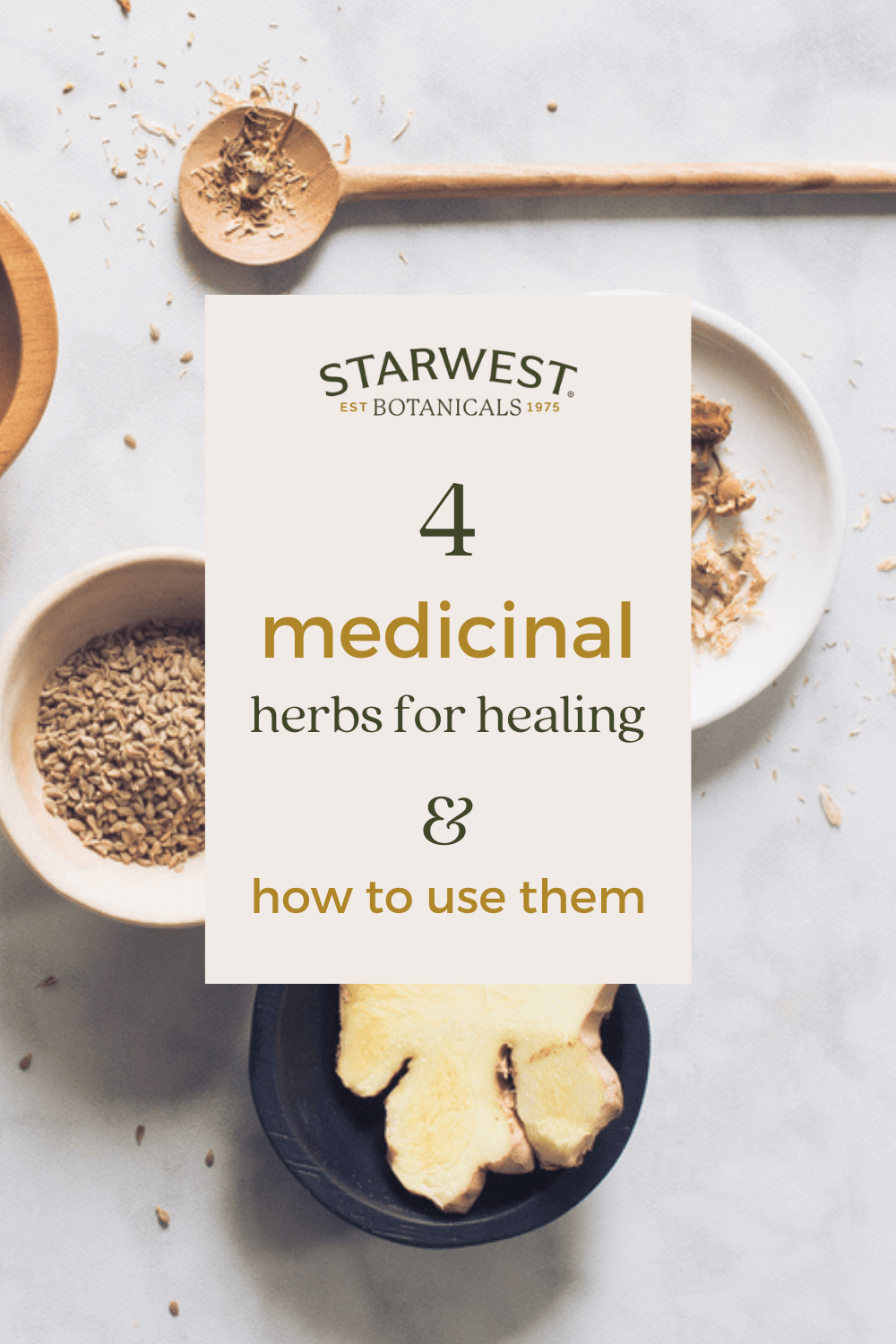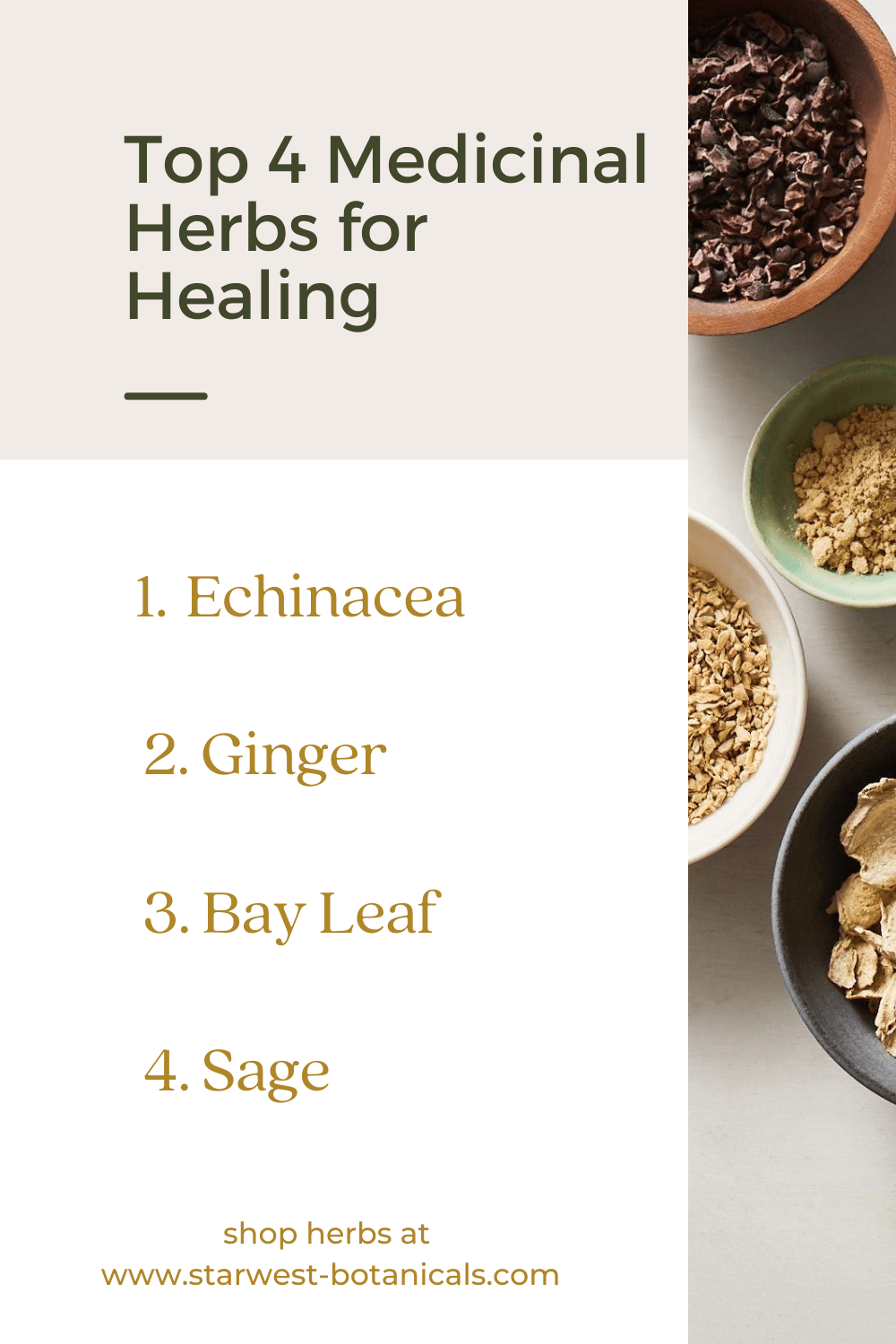Top 4 Medicinal Herbs for Healing | Starwest Botanicals
Posted by Starwest Botanicals Content Team | Medically Reviewed by Daniel Powers, MS on 07-06-2022

Top Four Medicinal Herbs for Healing and How to Use Them
If you’re reaching for the spice cabinet as much as the medicine cabinet on those days you’re feeling off, you’re in good company. While organic herbs are known for adding flavor to food, they’ve also been used as herbal medicine to help combat health concerns for thousands of years.
But with all the spices around, from anise to za’atar, it can be difficult to keep them straight. What is the difference between dried vs fresh herbs? How long do dried herbs last? Which ones come with a health benefit? Is ginger for digestion, or is that sage?
Keep reading for insight into the top herbs for medicinal purposes. In this guide, we’ll provide background information on each herb, cover their benefits, and offer suggestions for how to incorporate them into your daily life. Whether you’re looking for the best medicinal herbs to grow, savor, or enjoy, get ready to spice up your life.
#1 Echinacea
Echinacea, also known as the coneflower, is one of the foundational herbs to include on your spice rack. It originates in North America, where Native Americans used it as early as the 17th century to treat various ailments.
Benefits
What’s better than a healing herb that may naturally treat an ailment? A healing herb that can serve multiple functions!
- May Support The Immune System – According to a study in the Academic Journal Phytomedicine, echinacea may affect the immune system, stimulating changes in the concentration of cytokines, an important element in health.
How to Use Echinacea:
When it comes to taking echinacea, the great news is that this multifunctional herb comes in a wide variety of forms. You can stick with one that best suits your lifestyle or mix it up for a special treat. Consider the following ways to get your echinacea fill:
- Take an echinacea tablet or capsule with breakfast or lunch for maximum convenience.
- Add echinacea extract to a leafy green smoothie or nutrient-filled juice.
- Brew echinacea-infused tea for those days when you want to curl up and stay cozy.
At Starwest Botanicals, we sell a variety of different forms of echinacea, inclduing powders, tinctures, and dried whole herb. Try adding this herb to your routine to get the benefits of echinacea in your life.
#2 Ginger
If ginger isn’t on your weekly shopping list, it should be. This superb herb, with over five thousand years of history, comes from Southeast Asia. It has since spread across the globe, making an appearance in recipes from Indian ginger potatoes to Greek and Egyptian gingerbread.
Gingerol, an active ingredient in ginger root, is the secret sauce.
Benefits
One of the most versatile medicinal herbs you can find, ginger comes with many potential health benefits, including the following:
- More Efficient Digestion – According to Emma Slattery, a clinical dietitian with Hopkins Medicine, ginger helps to keep food moving along in the digestive tract. By keeping your gut clear, this herb may subsequently help relieve queasiness and heaviness after eating.
How to Use
Ginger comes in a variety of forms, perfect for seamless integration into your diet and lifestyle. Whether you’re beginning your day with a steaming cup of ginger honey tea or choosing a nightly serum with ginger extract, there are plenty of opportunities for medicinal use with this herb.
The following options may spark your creativity:
- Fresh Ginger Root – Go back to the basics with fresh ginger root, a pungent spice that can be added to a variety of dishes. Commonly used in Asia, fresh ginger can give a kick to meats, seafood, and vegetables. Next time you’re tired of the same old weekday dish, consider chopping up some ginger and adding it to the mix.
- Ginger Powder – Not in the mood to take out your chopping board? Opt for ginger powder instead. The smooth quality of the powder is perfect for soups, desserts, and various drinks.
- Ginger-Infused Liquids – From concentrated ginger oil to soothing ginger tea, this herb comes in numerous liquid forms. Finish off your lunch with a glass of cool ginger juice or add a drop of essential ginger oil to your nightly routine.

#3 Bay Leaf
When you’re feeling under the weather, perhaps nothing is more welcoming than a hot bowl of soup—complete with bay leaves. In fact, this potent culinary herb makes its way into a wide variety of brothy recipes to provide a flavorful pick-me-up for when you’re not feeling your best.
But the bay leaf isn’t just used for its aromatic flavors. Produced by the evergreen bay tree, indigenous to Asia and known later in the Mediterranean as the laurel tree, the bay leaf also comes with a host of natural remedies and potential benefits.
How to Use
Depending on the nature of your ailment, you may use bay leaves differently. Consider the following examples for how to incorporate this special herb into your life:
- Add bay leaves to your soups and broths.
- Steep your morning tea with bay leaves as a preventative measure.
- Mix bay leaf essential oil with an ointment of your choice and apply it over a healing wound.
#4 Sage
Originating in the Mediterranean region, this temperate herb is not only delicious when paired with creamy dishes, it may also come with a wealth of healing properties and long-term benefits. And is there anything better than an herb that tastes as good as it can make you feel?
Benefits
A member of the mint family, this aromatic herb has been recognized for its medicinal uses since ancient times. Top potential benefits may include the following:
- Antioxidant– Antioxidants are an essential part of any diet. The great news is that sage is full of antioxidants, containing over 160 varieties that can help promote long-term health.
How to Use
When it comes to consuming sage, a little goes a long way. This is because the herb is packed full of nutrients. Consider the following ways to add this potential medicinal herb into your routine:
- Start your mornings with a daily sage supplement, keeping the dosage between 280 mg and 1,500 mg daily.
- Opt for a sage tincture, an extract of the herb dissolved in ethanol alcohol. Place a drop on the tongue for twenty to thirty seconds before swallowing.
- Incorporate sage into your daily meals by rubbing it onto meats, mixing it into stuffings, or adding it into smoothies and juices.
Starwest Botanicals: Top-Notch Organic Herbs to Help Make Wellness Easy
Looking for the best medicinal herbs to add to your spice cabinet? At Starwest Botanicals, we believe that maintaining optimal health and wellness comes down to choosing organic, top-quality ingredients. That’s why our immune boosting herbs are held to the highest standards, coming straight from the source with a 100% satisfaction guarantee.
Talk to our expert customer service team about your goals, and we’ll provide you with all the information you need to make the right choices for your health. Whether you want to know the difference between herbs vs spices or how to store dried herbs, we are here to help. From herb-infused essential oils to herbal capsules, you’re sure to find that extra wellness boost you’ve been searching for.
Reviewed By: Allie Baker
Allie Baker is a California-based conscious copywriter and content strategist who partners with wellness and lifestyle brands to bring their vision to life.
Sources:
Auguste Escoffier School of Culinary Arts. All About Bay Leaves. https://www.escoffier.edu/blog/culinary-arts/all-about-bay-leaves/#:~:text=Bay%20leaves%20come%20from%20the,with%20Ancient%20Greece%20and%20Rome.
MasterClass. How to Cook With Sage: 11 Culinary Uses for Sage. https://www.masterclass.com/articles/how-to-cook-with-sage-11-culinary-uses-for-sage#what-is-the-history-of-the-sage-plant
Mayo Clinic. Antioxidants. https://www.mayoclinic.org/healthy-lifestyle/nutrition-and-healthy-eating/multimedia/antioxidants/sls-20076428#:~:text=Antioxidants%20are%20substances%20that%20may,to%20tobacco%20smoke%20or%20radiation.


